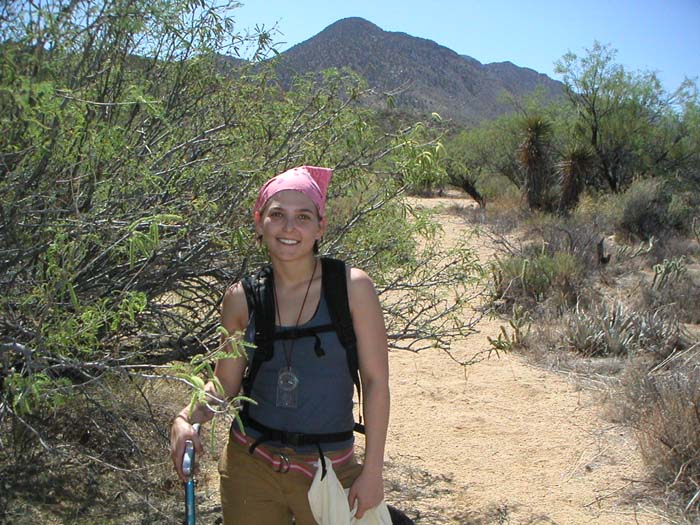Math Models Predict Climate Change Effects

This ScienceLives article was provided to LiveScience in partnership with the National Science Foundation.
When the climate changes a species' habitat, the species must track the moving habitat, adapt to the new climate or become extinct. Ongoing changes in climate are currently causing habitat loss and distribution shifts that could result in mass extinction. Because of these trends, wildlife species from the short-tailed chinchilla to the American pika are at risk.
A. Michelle Lawing — a postdoctoral fellow at the National Institute for Mathematical and Biological Synthesis — uses evolutionary biology methods and models combined with evidence from the fossil record to study the responses of species and communities to environmental change over time. Lawing has determined that geographical shifts in rattlesnake populations over the past 320,000 years were not due to evolutionary change, but rather to the rattlesnake's habitat tracking. Her models also indicate that many species will have to move both farther and faster than they have in the past to avoid extinction.
Lawing is expanding her research to cover vertebrates in North America, using mathematical models with a number of evolutionary variables to predict geographical shifts in species distribution, as well as to identify traits that are more sensitive or resistant to climate fluctuations.
You can read more about Lawing's research here.
Name: Michelle Lawing Age: 30 Institution: National Institute for Mathematical and Biological Synthesis Hometown: Rockport, TX Field of Study: Paleobiology
What inspired you to choose this field of study?
Get the world’s most fascinating discoveries delivered straight to your inbox.
As an undergraduate, I was inspired to pursue research in biology when I met evolutionary biologists studying the ecology, morphology (the form and structure of organisms) and systematics(the diversification of organisms and the relationships among them through time) of rattlesnakes. Shortly after, I was fortunate enough to tag along on field expeditions to collect rattlesnakes in the deserts of United States and Mexico. Spending time discussing research with these scientists, I realized being a researcher was the type of career I wanted to develop. After many years of development as a researcher, I came to understand the importance of geological time and highly dimensional systems (morphological shapes and climatic niches, or range of climatic conditions an organism is found in) in evolutionary and ecological processes. Now I study the influence of past climate change on these processes, and I apply mathematical models to study these processes in highly dimensional systems.
What is the best piece of advice you ever received?
Doing research, one often feels rushed to finish the experiments, analyze the results or write the paper. The best advice I received was to take my time. It is important to make sure to check and double check your work and your conclusions.
What was your first scientific experiment as a child?
My first scientific experiment was one of product testing: which soap produced the most suds. Treatments included the amount of lathering time and amount of water.
What is your favorite thing about being a scientist or researcher?
I enjoy the act of discovery. Specifically, I like to identify new patterns and build models that fit patterns to discover what biological processes are involved.
What is the most important characteristic a scientist must demonstrate in order to be an effective scientist?
I think this is highly variable depending on the scientist. For me, it is organization. Being organized allows me to keep pace with the many aspects of being a researcher, including data collection, data analysis, communicating results and conclusions, publishing, collaborations, teaching and giving presentations.
What are the societal benefits of your research?
Understanding how species responded geographically and evolutionarily to climate change in the past will allow us to make informed decisions on how to help them cope with impending climate change.
Who has had the most influence on your thinking as a researcher?
My dissertation advisor, Dr. P. David Polly, had the most influence on my thinking as a researcher. He is a vertebrate paleontologist who studies how the history of the Earth has affected the evolution and ecology of vertebrates. Dr. Polly provided a stimulating and flexible academic environment. He has a particularly keen perception, understanding, and ability to communicate quantitative problems in paleontology, biology and geology.
What about your field or being a scientist do you think would surprise people first?
My field has a strongly computational aspect to it. When people think of paleontology or paleobiology, they think of scientists digging in sand and rocks for fossil discoveries. I make discoveries on my computer with open access data compiled from online resources.
What music do you play most often in your office or car?
I always tune my radio station to National Public Radio (NPR).
Editor's Note: The researchers depicted in ScienceLives articles have been supported by the National Science Foundation, the federal agency charged with funding basic research and education across all fields of science and engineering. Any opinions, findings, and conclusions or recommendations expressed in this material are those of the author and do not necessarily reflect the views of the National Science Foundation. See the ScienceLives archive.



